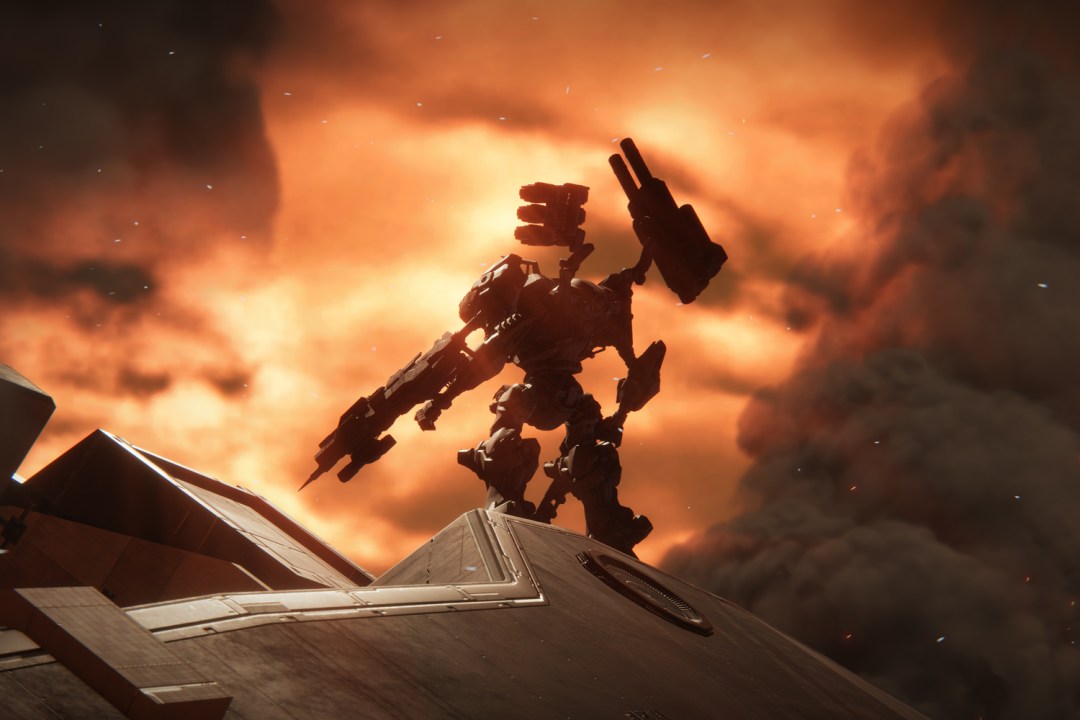Armored Core VI: Fires of Rubicon review – metal head
FromSoftware goes back to its mech roots - but with a hardcore Souls touch

Before it produced punishingly hard fantasy RPGs that regularly rank highly in best video games lists (ours included), FromSoftware was best known for mech combat series Armored Core. It’s been over a decade since the last instalment, but the studio’s unparalleled recent reputation has given it carte blanche to do whatever it wants. And what it wants is to head back to its roots.
Outdated mechanics might be out in favour of gameplay that’ll ease in newcomers, but we’re still talking about a studio that spend the last 14 years on the Dark Souls series and its offspring. Will Fires of Rubicon be the one that finally makes giant robot battle simulators mainstream?
Assembly required


You might imagine piloting a hulking war machine would be slow and cumbersome, but your Armored Core (or AC for short) is actually pretty agile. Boosters give full omnidirectional control, for more manoeuvrability than one of From’s fantasy RPG characters. The notorious ‘crab grip’ control scheme of the old Armored Core games is long gone, replaced with intuitive inputs that map your endless combination of energy swords, plasma rifles, machine guns and bazookas to the shoulder buttons and triggers.
Each high-tech machine brings some helpful UI and audio feedback, such as an automated voice warning you when your AP (health) has dropped to a certain percentage, or a chime a bit like a plane’s seat belt alert when you’re out of EN (stamina).
It’s definitely a more hardcore robot sim than the arcade mech action of Exoprimal, but the game does a terrific job of teaching the basics through the first chapter. Tutorials pop up regularly, and optional training missions carefully explain the different mechanics.
Credits earned by completing missions let you buy new parts for your AC, which not only drastically change their appearance but also their traversal and combat style. It sounds intimidating, but stats are clearly displayed to show the benefits and trade-offs of each new part.
For instance, an AC with lightweight reverse-joint legs is agile and jumps high, but has low defence and less likely to wield heavy firepower; one with big tank treads is slow but high on defence. It also helps that some of these different builds are also available to try in training missions, which award parts as an added incentive for completing them.
Robot Wars


Much like previous entries, Armored Core VI is all mission-based, some which only last a few minutes. While there’s a great deal of verticality that puts your AC’s boosters to good use, you don’t get to explore much of the desolate-looking planet Rubicon before running into artificial barriers.
The range of objectives and the scale of mech battles can vary, such as an early mission where you get to take down a whole battleship. The highlights involve going 1v1 with another AC, as you try to parse their moves before countering with your own. On rare occasions you’ll have an ally, or have to face a pair of opponents at once.
One strong tactical emphasis is on attacking your opponent until they’re staggered, which turns every attack in that short window into a critical hit. The trick is ensuring you don’t blow all your firepower just to stagger them, leaving your weapons empty or overheated during the stagger window. There’s also a danger you actually run out of ammo before a mission is complete.
This becomes more satisfying as more gear options open up throughout the campaign and you also get a feel for the rhythm of your weapon firepower, though that does mean initial encounters feel trickier as a result. Bosses that conclude each chapter have a habit of feeling needlessly difficult, with spongey health bars, multiple attack patterns and even tougher late phases, which almost feels like a bid to appeal to the Dark Souls crowd. It’s still a matter of getting good then, though there’s at least some generous checkpointing, and understanding the best assembly for your AC also goes a long way.
A snappier and more enjoyable challenge comes in the Arena, where you can take part in virtual 1v1 duels against a range of ACs. With the right assembly a match can be over within 30 seconds. These matches also award you with OS chips that can further enhance your AC, such as a last-shot shield when your AP reaches zero (sometimes the difference between victory and defeat) and a boost kick that can hilariously punt smaller enemies into oblivion. Also worth noting is an unlockable PvP mode where you can duel with other players in 1v1 or 3v3 mech battles, though unfortunately servers were not accessible to us at the time of review.
Sortie your life out


If you’re expecting the same sophisticated environmental world-building as Dark Souls or Elden Ring, then you’ll be disappointed. Mission environments are already quite limited by Rubicon’s barren wasteland or (in your AC’s perspective) miniature factories and buildings that look like a disposable set from a mecha/kaiju show. The game does still look fantastic when centred on its mechs though. For those who really want to personalise their ACs in the garage, you’ve got a comprehensive suite of paint jobs, unlockable decals, while you can even create your own designs with an image editor.
But while there are a lot of characters you encounter in the story, that you only hear them over radio comms and never see a face, not even your own character. They’re an augmented human who initially just goes by a code number, means there’s something of a disconnect, a lack of humanity or soul (pun not intended, sort of). Despite a story that has you being pulled between allegiances, from rival corporations to the lowly mercenaries to the native Rubiconians fighting for their freedom, we found ourselves struggling to engage with it.
It does however make the campaign, already a reasonably shorter length than From’s RPGs provided you don’t get stuck on any of the major bosses, considerably replayable. You sometimes have choices over which missions to take that can alter your path, with a few different endings available.
That the game also unceremoniously drops you back to the beginning of the story after the credits roll more or less incentivises you to give it another run. It’s not New Game+ in terms of difficulty, but it does open up alternative options to certain missions that weren’t available the first time, and even unlocks completely new missions. Plus, when you get to go up against a seemingly impossible boss fight that you can now steamroll thanks to your new mech parts and upgrades, there’s a real sense of satisfaction with how far you’ve come.
Armored Core VI: Fires of Rubicon verdict


After more than a decade on hiatus, Armored Core VI brings FromSoftware back to its mecha-based roots. This latest entry is just as in-depth as it always has been in that niche genre of big robot sims, while still going some way to being an excellent entrypoint for newcomers.
It’s unlikely to set the world on fire in the way its fantasy action RPGs have done so in the past decade, being a bit too cold for those looking for deep lore to invest in, and its more Soulsy mechanics feel a little unwarranted at times. Yet when other developers are still trying to ride on the coattails of From’s recent successes, it’s refreshing to see the studio marching to the beat of its own drum with a game that will delight mech heads.
Stuff Says…
Excellent mech battles with deep customisation even if it’s missing the same spark (or Souls) of FromSoftware’s fantasy blockbusters
Good Stuff
Not just for series veterans
Ridiculously intricate mech customisation
Fun and challenging battles in manageable bursts
Bad Stuff
Not especially engaging story or world
Some bosses feel needlessly difficult



